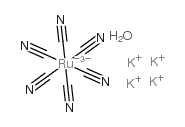15002-31-0
| Name | potassium hexacyanoruthenate(ii) hydrate |
|---|---|
| Synonyms |
Potassium Hexacyanoruthenate Trihydrate
MFCD00168064 EINECS 239-097-1 Cyanometalpotassiumsalt potassium ruthenium cyanide |
| Boiling Point | 25.7ºC at 760mmHg |
|---|---|
| Molecular Formula | C6H2K4N6ORu+ |
| Molecular Weight | 431.58300 |
| Exact Mass | 431.78800 |
| PSA | 151.97000 |
| LogP | 0.03638 |
| Vapour Pressure | 740mmHg at 25°C |
|
Section 1: Product Identification Chemical Name:Potassium hexacyanoruthenate (II) hydrate CAS Registry Number:15002-31-0 Formula:K4Ru(CN)6.XH2O EINECS Number:239-097-1 Chemical Family:metal cyano complex Synonym:Potassium ruthenocyanide, Ruthenate(4-), hexakis(cyano-C)-, tetrapotassium
Section 2: Composition and Information on Ingredients IngredientCAS NumberPercentACGIH (TWA)OSHA (PEL) Title Compound15002-31-0100%no datano data Section 3: Hazards Identification Emergency Overview:Irritating to the respiratory tract, skin and eyes. May be harmful if swallowed. Primary Routes of Exposure:Ingestion, eyes Eye Contact:Causes slight to mild irritation of the eyes. Skin Contact:Causes slight to mild irritation of the skin. Inhalation:Irritating to skin, eyes and respiratory tract. Ingestion:Ingestion may lead to dizziness, abdominal cramps, and vomiting. Acute Health Affects:Irritating to skin, eyes and respiratory tract. The toxicological properties of this compound have not been thoroughly investigated. Unrecognized hazards Chronic Health Affects: may be present. NTP:No IARC:No OSHA:No SECTION 4: First Aid Measures Immediately flush the eyes with copious amounts of water for at least 10-15 minutes. A victim may need Eye Exposure: assistance in keeping their eye lids open. Get immediate medical attention. Wash the affected area with water. Remove contaminated clothes if necessary. Seek medical assistance if Skin Exposure: irritation persists. Remove the victim to fresh air. Closely monitor the victim for signs of respiratory problems, such as difficulty Inhalation: in breathing, coughing, wheezing, or pain. In such cases seek immediate medical assistance. Seek medical attention immediately. Keep the victim calm. Give the victim water (only if conscious). Induce Ingestion: vomiting only if directed by medical personnel. SECTION 5: Fire Fighting Measures Flash Point:not applicable Autoignition Temperature:none Explosion Limits:none Extinguishing Medium:none required If this product is involved in a fire, fire fighters should be equipped with a NIOSH approved positive pressure Special Fire Fighting Procedures: self- contained breathing apparatus and full protective clothing. Hazardous Combustion andIf involved in a fire this material may emit irritating fumes. Decomposion Products: Unusual Fire or Explosion Hazards: No unusual fire or explosion hazards. SECTION 6: Accidental Release Measures To avoid raising dust, small spills may be mixed with diatomaceous earth, sand, vermiculite or other suitable Spill and Leak Procedures: inert material and swept up. SECTION 7: Handling and Storage Handling and Storage:Store in a cool, dry area away from heat and direct sunlight. SECTION 8: Exposure Controls and Personal Protection Eye Protection:Always wear approved safety glasses when handling a chemical substance in the laboratory. Skin Protection:Wear protective clothing and gloves. Ventilation:Material may form a fine dust. If possible, handle the material in an efficient fume hood. If ventilation is not available a respirator should be worn. The use of respirators requires a Respirator Respirator: Protection Program to be in compliance with 29 CFR 1910.134. Ventilation:Material may form a fine dust. If possible, handle the material in an efficient fume hood. Additional Protection:No additional protection required. SECTION 9: Physical and Chemical Properties Color and Form:white powder Molecular Weight:413.59 Melting Point:no data Boiling Point:no data Vapor Pressure:not applicable Specific Gravity:no data Odor:none Solubility in Water:soluble SECTION 10: Stability and Reactivity Stability:air and moisture stable Hazardous Polymerization:no hazardous polymerization Conditions to Avoid:Very strong oxidizing agents such as nitric acid may produce toxic volatile ruthenium tetroxide. Incompatibility:Mineral acids, oxidizing agents and active metals Decomposition Products:carbon dioxide, carbon monoxide, nitrogen oxides, organic fumes, and ruthenium oxide SECTION 11: Toxicological Information RTECS Data:No information available in the RTECS files. Carcinogenic Effects:No data Mutagenic Effects:No data Tetratogenic Effects:No data SECTION 12: Ecological Information Ecological Information:No information available SECTION 13: Disposal Considerations Disposal:Dispose of according to local, state and federal regulations. SECTION 14: Transportation Shipping Name (CFR):Non-hazardous Hazard Class (CFR):NA Additional Hazard Class (CFR):NA Packaging Group (CFR):NA UN ID Number (CFR):NA Shipping Name (IATA):Non-hazardous Hazard Class (IATA):NA Additional Hazard Class (IATA):NA Packaging Group (IATA):NA UN ID Number (IATA):NA SECTION 15: Regulatory Information TSCA:Not listed in the TSCA inventory. SARA (Title 313):Title compound not listed. Second Ingredient:none SECTION 16 - ADDITIONAL INFORMATION N/A |
| Hazard Codes | T: Toxic; |
|---|---|
| Risk Phrases | 23/24/25-36/37/38 |
| Safety Phrases | 26-36/37/39-45 |
| RIDADR | UN 1588 6.1/PG 2 |
| Packaging Group | III |
| Hazard Class | 6.1(b) |
